Global nuts and seeds quality control inspection
Global nuts and seeds quality control inspection
South America, Africa, Asia and global, there are a lot of nuts and seeds are grown on farms or gathered in natural forests, in trading, 16 nuts and seeds high in protein and nutrition
Nuts and seeds are a heart-healthy snack in lower cholesterol. Its fiber and fats also be a good source of protein.
List of Global nuts and seeds quality control inspection
Global nuts and seeds quality control inspection and certification services issued on Hemp Seeds, Squash and Pumpkin Seeds, Peanuts, Almonds nuts, Pistachios, Sunflower Seeds, Flax Seeds, Sesame Seeds, Chia Seeds, Cashews, Walnuts, Hazelnuts, Pine Nuts, Pecans, Macadamia Nuts, Dried Coconut, and more
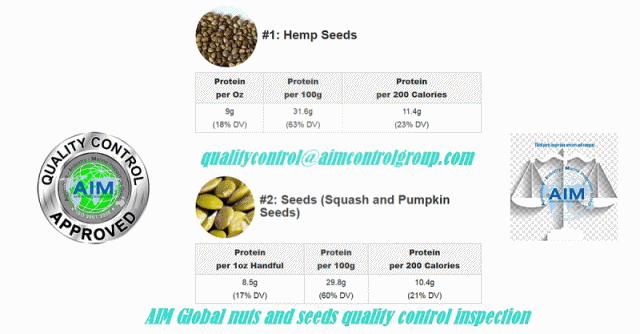
Culinary nuts are divided into fruits or seeds in one of four categories:
True, or botanical nuts: dry, hard-shelled, non-compartmented fruit that do not split on maturity to release seeds
-
Smoked almonds
-
Almonds (Prunus dulcis)
-
Apricot kernels.
-
Australian cashew nut
-
Betel or areca nuts
-
Borneo tallow nuts
-
Canarium nut
-
Pili nuts
-
Chilean hazel (Gevuina avellana)
-
Gabon nut (Coula edulis)
-
Hickory (Carya spp.)
-
Mockernut hickory (Carya tomentosa)
-
Pecans (Carya illinoinensis)
-
Shagbark hickory (Carya ovata)
-
Shellbark hickory (Carya laciniosa)
-
Bush mango (Irvingia gabonensis)
-
Ogbono nut (Irvingia wombolu)
-
Jack nuts (Artocarpus heterophyllus)
-
Jelly Palm Nut (Butea Capitata)
-
Bread Nuts (Artocarpus camansi)
-
Panda oleosa
-
Pekea nut, or butter-nut of Guiana (Caryocar nuciferum)
-
Pistachio (Pistacia vera L.)
-
Walnut (Juglans spp.)
-
Black walnut (Juglans nigra)
-
Butternut (Juglans cinerea) (or white walnut)
-
English walnut (Juglans regia) (or Persian walnut)
-
Heartnut, or Japanese walnut
Drupes: seed contained within a pit (stone or pyrene) that itself is surrounded by a fleshy fruit (e.g. almonds)
-
Acorn (Quercus, Lithocarpus and Cyclobalanopsis spp.),
-
Afghan hazelnut (Hircum nuces)
-
Beech (Fagus spp.) American beech and European beech
-
Breadnut (Brosimum alicastrum)
-
Candlenut (Aleurites moluccana)
-
Chestnuts (Castanea spp.)
-
Chinese chestnuts (Castanea mollissima)
-
Sweet chestnuts (Castanea sativa)
-
Hazelnuts (Corylus spp.)
-
Deeknut (Corylus Dikana)
-
Eastern and western beaked hazel (Corylus cornuta)
-
European hazelnut (Corylus avellana)
-
Filbert (Corylus maxima)
-
Hazelnut (C. heterophylla)
-
Johnstone River almond (Elaeocarpus bancroftii)
-
Karuka (Pandanus spp.)
-
Planted karuka (Pandanus julianettii)
-
Wild karuka (Pandanus brosimos)
-
Kola nut (Cola spp.)
-
Kurrajong (Brachychiton spp.)
-
Malabar chestnut (Pachira aquatica)
-
Mongongo (Ricinodendron rautanenii)
-
Palm nuts (Elaeis guineensis)
-
Red bopple nut (Hicksbeachia pinnatifolia)
-
Yellow walnut (Beilschmiedia bancroftii)
Gymnosperm seeds: naked seeds, with no enclosure (e.g. pine nuts)
-
Cycads (Macrozamia spp.)
-
Burrawang nut (Macrozamia communis)
-
Ginkgo nuts (Ginkgo biloba)
-
Araucaria spp.
-
Bunya nut (Araucaria bidwillii)
-
Monkey-puzzle nut (Araucaria araucana)
-
Paraná pine nut (Araucaria angustifolia) (or Brazil pine nut)
-
Pine nuts (Pinus spp.)
-
Chilgoza pine (Pinus gerardiana)
-
Colorado pinyon (Pinus edulis)
-
Korean pine (Pinus koraiensis)
-
Mexican pinyon (Pinus cembroides)
-
Single-leaf pinyon (Pinus monophylla)
-
Stone pine, or pignolia nut (Pinus pinea)
Angiosperm: seeds surrounded by an enclosure, such as a pod or a fruit (e.g. peanuts).
-
Macadamia (Macadamia spp.)
-
Macadamia nut (Macadamia tetraphylla)
-
Queensland macadamia nut (Macadamia integrifolia)
-
Paradise nut (Lecythis usitata)
-
Peanut, or groundnut (Arachis hypogaea)
-
Peanut tree (Sterculia quadrifida)
-
Soybeans (Glycine max)
For example AIM’s Brazil nuts quality control and inspection
Brazil nuts (Bertholletia excelsa) are harvested from an estimated 250,000–400,000 trees per year. Highly valued edible nut used in the confectionery and baking trades. Excellent dietary source of selenium.
Country of Origin is Peru
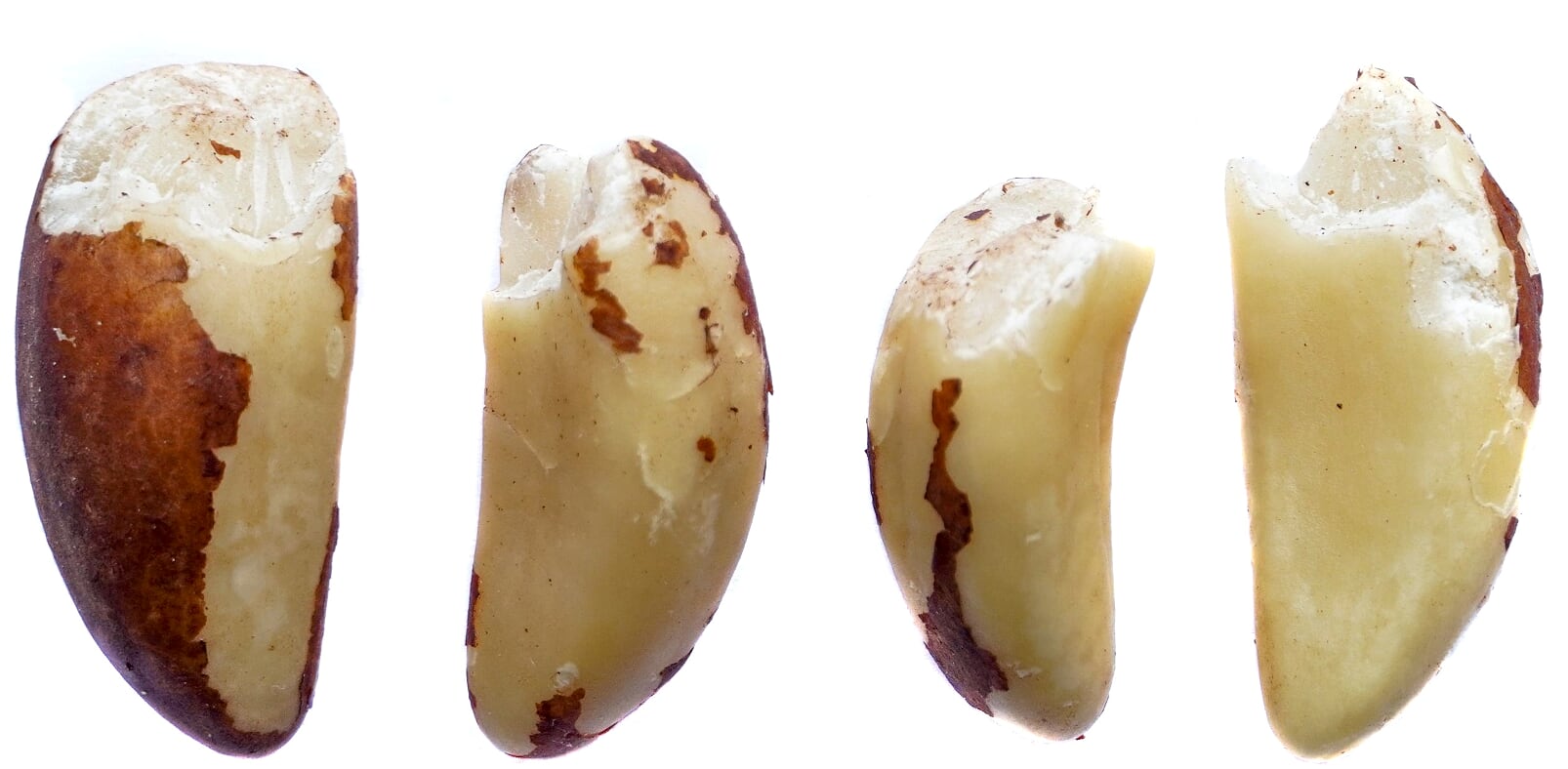
-
This product of Brazil Nuts is graded using the United States AFI specifications for consumption
-
GM status: No Genetically Modified product
-
Size classification: Medium: 242 - 286 Kernels per Kg and Midget: 352 - 396 Kernels per Kg
-
Sensory characteristics:
-
Appearance & Colour: Typically light brown colour, partially covered by brown skin
-
Flavour & Aroma: Odour and flavour typical to the brazil nut with no off taints and odours
-
Texture: Crisp and firm, not pliable or leathery. May or not may contain skin
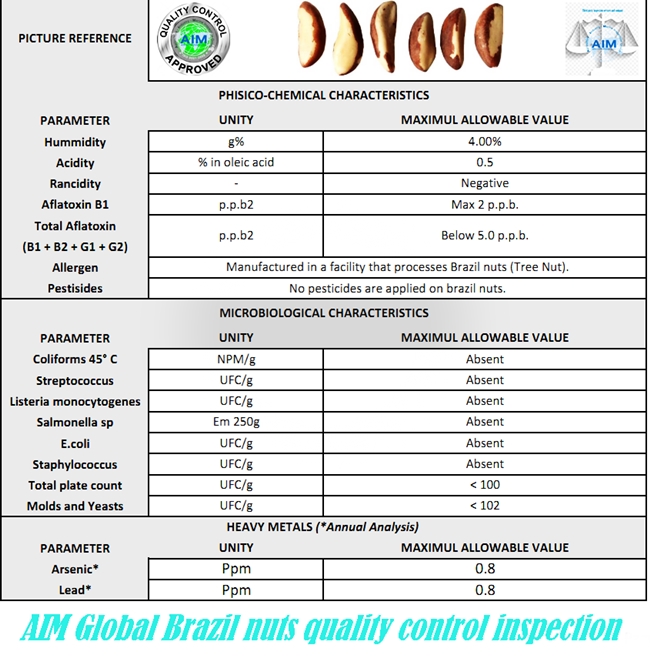
Broken nuts
-
There is an excess number of ‘broken nuts’.
-
Definition of a broken nut as per standard product specification of Brazil Nuts: kernel with more than ¼ of the kernel missing.
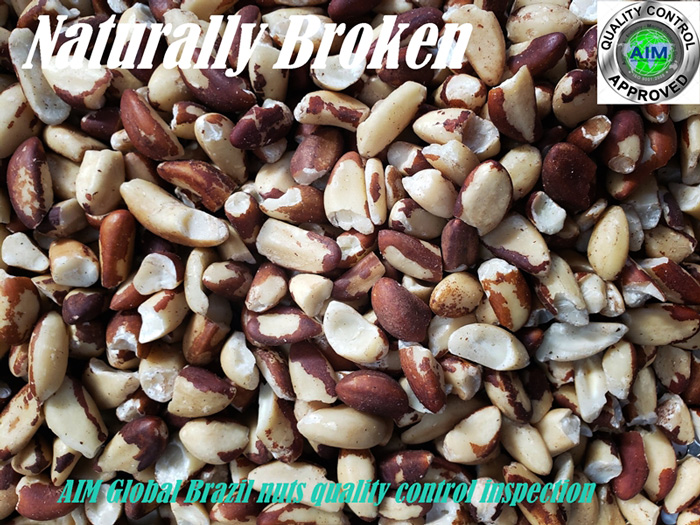
Chipped kernel
-
There is an excess of nuts that are missing a piece. We call them chipped.
-
Definition of ‘Chipped nut’ as per standard product specification of Brazil Nuts: scarred kernel with less than ¼ of the whole kernel missing, or more than ¼ of the diameter affected.

Sliced kernel
-
There is an excess of ‘pieces’
-
Definition of ‘pieces’ as per standard product specification of Brazil Nuts: kernel fragment that represent ¼ of the kernel or less.
Regarding other quality to no complain:
-
Taste, humidity, smell, rancidity, physiochemical, microbiological or with heavy metals in free
Packing/ Marking and Material
-
Carton boxes and inside bags are in good condition.
-
All of these qualities do need to be reviewed.
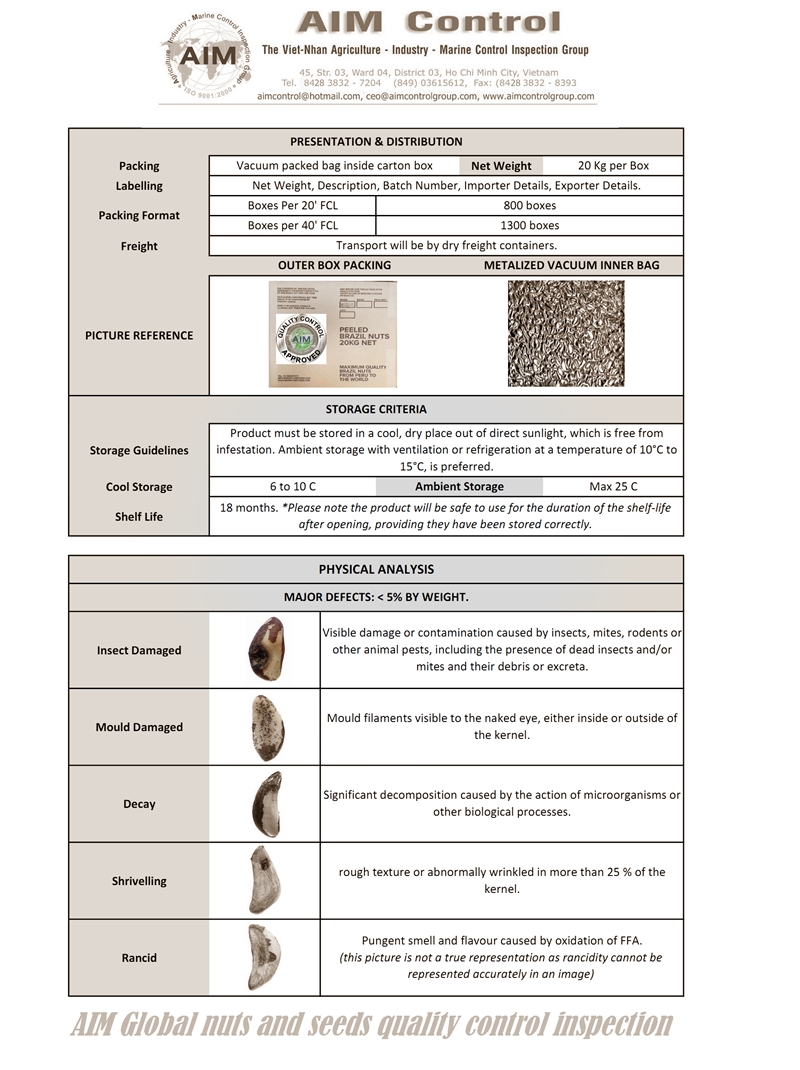
About Product Specification of Brazil Nuts
-
Broken nuts, pieces and chipped nuts are considered a ‘minor defect’. Total sum of minor defects should be max 10% per box. Hence, the total sum of broken nuts, pieces and chipped nuts inside a should be maximum 10%. These are the same specifications that are used in the Brazil Nut Industry.
-
Also: Is common to find nuts that have a ‘scratch’ on the surface. These type of nuts are not considered a defect. They are not considered a defect under any product specification in the industry. ‘scratched nuts’.
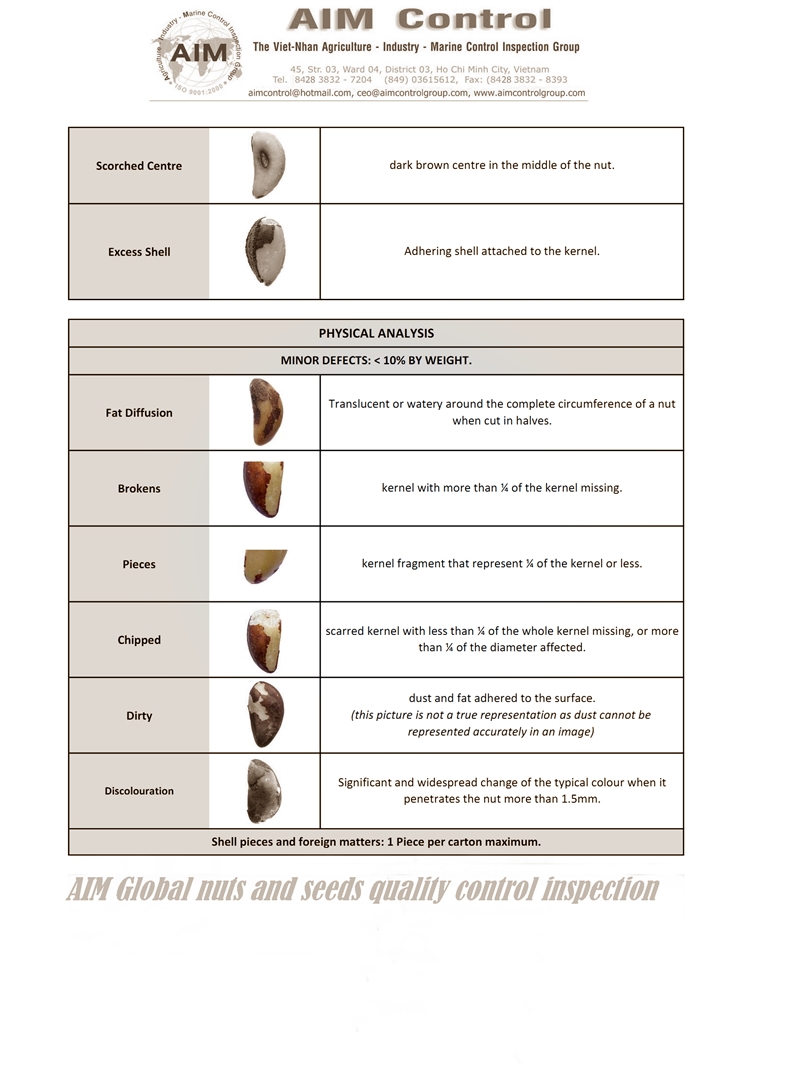
Assignment of the quality inspection for nuts or seeds:
To take a representative sample, and understand the total sum (in percentage) of broken nuts, pieces and chipped nuts on this cargo.
-
for physical
-
for lab.
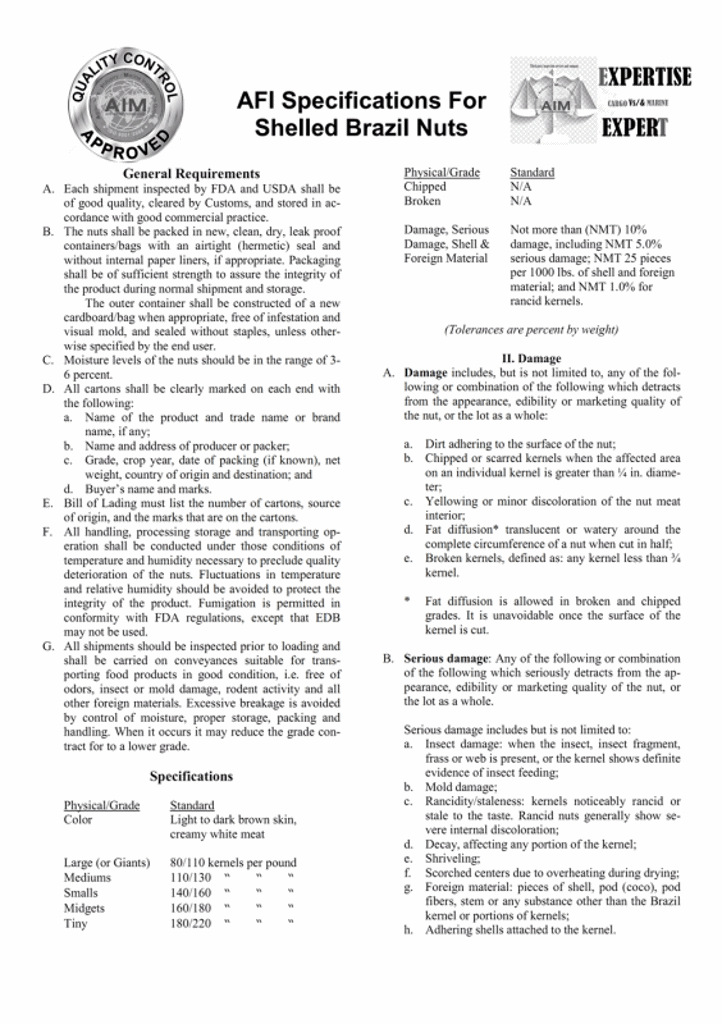
Also see AIM’s cashews quality control inspection done by us
Other news :
- Fruits quality control and certification
- Quality potato inspection and certification
- Collateral Management International
- Coffee Inspection
- Reefer cargo inspection services
- Wheat quality inspection
- QA QC on animal feed ingredients in aquaculture feed
- Agricultural products quality assurance aquaculture quality control
- Quality inspection Meat and bone meal
- Agricultural commodities quality inspection services







